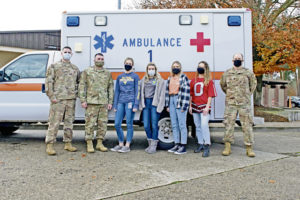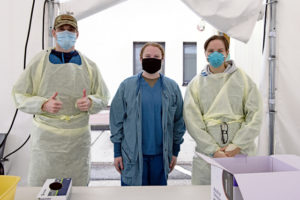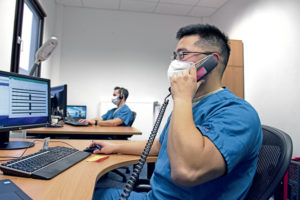
In the eight months since COVID-19 arrived on base, Ramstein has come a long way.
Past and present 86th Airlift Wing leadership allow for a comparison of Ramstein’s initial reactions to the virus with how they’re currently managing.
In March the base confirmed its first case of COVID-19, marking a step into uncharted territory. Operations had to be flexible to prevent the spread of the virus.
Maj. David Mackintosh, 86th Airlift Wing plans and programs officer from March through May and current 3rd Air Force Commander’s Action Group member, led the way in uncertain times. He took over COVID-19 operations when the virus quickly became a theatre-wide issue.
As plans were made, important questions from the public continued to mount: How would base residents be safe? Would children still go to Child Development Centers? Would schools remain open? These were questions leaders had to answer at a rapid pace, gathering Airmen from many units that ranged from the 86th Force Support Squadron to 86th Maintenance Squadron into the operational planning team.
At the same time businesses and borders were closing, Ramstein continued to operate as the “Gateway to the World.” Another challenge was keeping the base safe from COVID-19 while remaining open.

“It was a balancing act to manage the requirements coming through Ramstein,” Mackintosh said. “There are some users who had no issues leaving the (passenger) terminal and going to stay at Vogelweh, but there’s some users who could not leave Ramstein because we had to make sure they weren’t infected.”
Leadership also had to contend with rapidly changing guidance, from wing-level to as far up as Department of Defense guidance. Accounting for host nation guidance added another level of difficulty.
“(It) was a significant challenge early on keeping up with everything and not knowing when the next level of headquarters guidance was going to come down and how it might restrict us further,” said Maj. Joe Baldwin, 86th Airlift Wing plans and programs action officer and COVID-19 operational planning team leader. “There wasn’t a great mechanism for all of that to get distributed and communicated.”
It wasn’t until June when things settled into a new normal for Baldwin and his team. Businesses began to re-open and the health protection condition downgraded to Bravo. Brig. Gen. Mark R. August, the previous 86th AW commander, stood down the operational planning team, but Baldwin remained to handle COVID-19 operations.

“We got into this rhythm,” Baldwin said. “We’re getting deployments going through again, operations are picking back up again, we’re allowing base and morale events again.”
Brig. Gen. Josh Olson, 86th AW commander, resumed the operational planning team in August, prioritizing a single point of contact and streamlined communication for COVID-19 operations. Experience from previous COVID-19 experiences allowed Baldwin and his team to better prepare for future potential outbreaks.
The ordeal was one of the most challenging events in Mackintosh’s career, but what made it rewarding was how unrestricted he was.
“Since there wasn’t any existing guidance in how this has ever been done before we came up with it on our own using all the experts we had in the room,” Mackintosh said.
What made the experience memorable for Baldwin was getting to see all the various units on Ramstein and how they worked together.
“There are so many different mission sets represented on Ramstein,” Baldwin said. “It’s unbelievable. (For example,) seeing how important the role of Public Affairs is and seeing all the different things Mission Support Group does is incredible.”
As temperatures drop, COVID-19 cases continue to rise across Germany. Rest assured, with preparation and communication Ramstein will be ready for the challenge.


